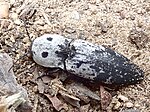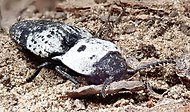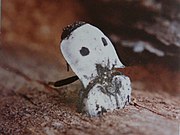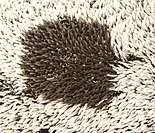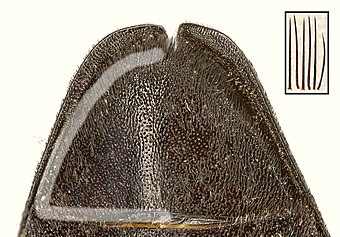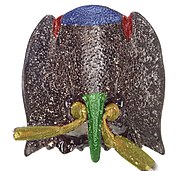Calais parreysii
| Calais parreysii | ||||||||||||
|---|---|---|---|---|---|---|---|---|---|---|---|---|
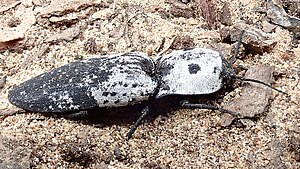
Calais parreysii |
||||||||||||
| Systematics | ||||||||||||
|
||||||||||||
| Scientific name | ||||||||||||
| Calais parreysii | ||||||||||||
| ( Steven , 1829) |
Calais parreysii from the family of beetles is up to 40 millimeters in length, the largest European representative. The genus Calais is onlyrepresentedin Europe with the species Calais parreysii .
The beetle is on the red list of the IUCN out for Europe "endangered species fast" than with "decreasing population development". The species does not occur in Central Europe. In the Crimea , the beetle is classified as "endangered".
Comment on the name
The beetle was first described by Christian von Steven in 1829 . Mentioned by Steven that the Viennese insect dealer Parreys gave him the beetle to describe. Parreys found the beetle under the bark of a dead Tauride pine ( Pinus taurica , subspecies of the black pine ) high in the mountains of the Crimean Mountains above Alupka .
Although the beetle had already been found the previous year by a Mr Wavre from Neufchâtel , Steven named it Parreysii in honor of Parreys Elater . The genus Elater (from ancient Gr . Ἐλᾰτήρ elatēr, “impeller”, “slinger” because of the beetle's ability to jump up) originally included all click beetles. Eschscholtz split the large genus Elater into 37 genera in 1829 . Based on its properties, Latreille assigned the beetles to the genus Alaus , which is characterized by its scale-like hairiness. The word Alaus is derived from the ancient Greek ἀλαός, alaos, which stands for "blind". It alludes to the fact that two spots on the breast shield simulate eyes that can be described as blind. In 1836 Laporte de Castelnau delimited the genus Calais from the genus Alaus . The name Calaϊs possibly refers to the figure Kalaïs (κάλαϊς) from Greek mythology . The genus name Calais was also used by Rafinesque in 1815 for a group of crustaceans and in 1836 by Boisduval for a genus of butterflies. In both cases, however, the use of the name does not comply with the zoological nomenclature rules .
Properties of the beetle
The basic color of the 30 to 40 millimeter long beetle is black and dull, but partly black, partly dense silver-white, which creates a conspicuous black-and-white pattern, especially on the pronotum. The pronotum appears light gray with two large black dots that look like eyes (scaling in the area of an “eye” in Fig. 5). In addition, there are still a few spots without white scales near the base of the pronotum. The wing covers are almost black in the rear half and are first lightly spotted by the increasingly dense white scales towards the base, then light gray with dark spots.
The feelers (Fig. 2) have eleven sections. The second antenna segment is very small, the following ones are triangular and sawn inwards, the last one is egg-shaped and has a small cutout in front of the tip (arrowhead in the box in Fig. 2).
The pronotum is almost as long as it is wide, its front part is widened and arched strongly like a pillow, the pointed rear angles protrude backwards and outwards.
The label is rounded to ovoid. It is raised and falls abruptly towards the front (clearly visible in Fig. 1, top right).
The elytra are more than twice as long as together wide. At the base they are as wide as the pronotum, they gradually narrow towards the back. The base of the wing covers is arched on both sides.
On the underside of the first breast section (Prosternum, Fig. 7), a rounded widening (chin band, mentonnière, in Fig. 7 tinted blue) is formed towards the front. To the side of this, on both sides, there is a very short, but concise, incised sensor groove (tinted red in Fig. 7), into which the base links of the sensors can be inserted. The extension of the fore chest to the mid-chest is narrow and long (green in Fig. 7). It can be placed in the middle chest and enables the beetle to jump up. The hips of the hind legs are slightly expanded inward. The tarsi (Fig. 3) of all legs are five-limbed and laterally compressed, the tarsi-limbs on the underside without bristles or appendages. The claws are simple. An unusual sexual dimorphism is formed on the underside of the beetle. In the female, the 5th sternite has approximately the shape of a trapezoid (indicated by a wide white line on the top left of the picture in Fig. 6). At the rear edge of the 5th sternite there are long, dense hairs that are partially split at the end and resemble a trowel (enlarged in the box in Fig. 6 above). In the male, the shape of the 5th sternite is more rounded (indicated in Fig. 6 at the bottom of the left picture by a wide white line) and the hairs on the rear edge of the 5th sternite are pointed (enlarged in the box in Fig. 6, bottom).
Biology and protection
The beetle develops in autochthonous coniferous forests in the dead wood of various types of pine, in still standing trunks or in the stumps of felled pine trees. The infested trees are stated to be found in damp locations. However, this is not uncontested. It is reported from the Crimea that trees that have died due to fire are not infested.
The larva lives predatory on other arthropods in the infected trunks. It pupates in the wood (hatch Fig. 4).
The beetles are present in the Crimea from late April to July.
In a book about birds from the 19th century, it is reported that the gray woodpecker on the southern coast of the Black Sea mainly feeds on larvae of the beetle.
Protective measures
As protective measures, it is recommended not to remove dead wood from the forests, not to reduce the forest area of autochthonous forests and to reduce the risk of forest fires.
distribution
The species is widespread from the Balkan Peninsula to western central Asia and the Middle East ( Croatia , Greece , Cyprus , Syria , Turkey , Iran, Caucasus , Crimea , Black Sea ).
Web links
Individual evidence
- ↑ a b Calais parreysii from Fauna Europaea, accessed on May 1, 2019
- ↑ Data sheet for Calais parreysii
- ↑ a b c d Alexander_Fateryga: Red book of the Republic of Crimea Animals (Russian), p. 117
- ↑ Chr. Steven: Notice sur quelques insectes de la collection de C. Steven in Bulletin de la Société Imperiale des Naturalistes de Moscou Volume 1 No. IX, Moscow 1829, pp. 284ff p. 285
- ↑ a b Wilhelm Pape : Concise Dictionary of the Greek Language 3rd Edition Braunschweig 1914, p. 790 ἐλᾰτήρ and p. 89 ἀλαός
- ↑ Sigmund Schenkling: Explanation of the scientific beetle names (genus)
- ^ Johann Friedrich von Eschscholtz: Division of the Elaterids into genera . In Entomological Archives , 2 (1): 31–35
- ^ Ouvrage posthumously de M. Latreille: Distribution de la famille de Serricornes . In Annales de la Société Entomologique de France 3rd volume, Paris 1834, p. 113 ff, Alaus p. 141
- ↑ Meaning of Alaus according to the bug guide
- ↑ FL de Laporte: Études entomologiques, ou Déscriptions d'insectes nouveaux et observations sur la synonymie . In Revue entomologique de Gustave Silbermann, Tome IV, page 5 ff, Strasbourg, Paris 1836, Calais p. 9
- ↑ CS Rafinesque: Analyze de la Nature ou Tableau de l'Univers et des Corps organisés Palerme 1815, p. 99 9th family, 2nd subfamily, 7th genus Calais
- ↑ J. Boisduval: Histoire naturelle des Insectes. Spécies général des Lépidoptères Vol. 1 Paris 1836, p. 584
- ↑ a b A. Neboiss: The Genera Paracalais Gen. Nov and Austrocalais Gen. Nov. (Elateridae) . In Proceedings of the Royal Society of Victoria New Series Vol. 80, pp. 259 ff Melbourne 1967 [1]
- ↑ Ludwig Redtenbacher: Fauna Austriaca - The Beetles 3rd edition, 1st volume, Vienna 1874, p. 529 as Alaus Parreyssi
- ^ ME Candèze: Monograph des Élaterides . In Mémoires de la Société Royale des Sciences de Liége Volume Liége (Liège) 1857, p. 223, p. 223 f as Alaus Parreysi
- ^ Adrian P. Fowles: The Click-Beetles (Col. Elateridae & Eucnemidae) of Thásos [2]
- ^ HE Dressler: A History of the birds of Europe Vol. V, London 1871-1881, p. 98
